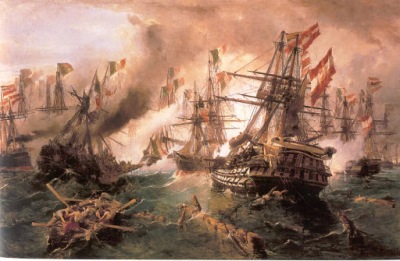It was on this day in 1866 that the naval battle of Lissa was fought, during the Third Italian War of Independence, which was a stunning defeat for the Kingdom of Italy. In the end, the Prussian victory over Austria eventually brought Venice back into the Italian nation but no more, with other formerly Venetian territories remaining under Austrian control. The battle was a loss for a variety of reasons, paramount of which was probably the feuding Italian commanders failing to put personal squabbles aside for the sake of the country and work together but also some faulty naval ordinance. Austrian shells penetrated Italian ships while Italian shells often bounced off the Austrian vessels (many of which included Italian sailors as well). However, despite being a defeat, there were still moments of extreme heroism and sacrifice on the part of the Italian fleet; such as the sailors of the Palestro refusing to abandon ship but staying with their captain and going down fighting. It did not help that the battle was first reported as a victory which only made the eventual news of defeat all the more shocking and terrible. Worse, it was mostly hushed up by the high command whereas it should have been looked at honestly to learn from the mistakes made.
The interval of ninety years between the end of the Napoleonic Wars in 1815 and the beginning of the Russo-Japanese War in 1904 was marked by no major naval war. There was fighting at sea, and there were prolonged blockades, but there were no campaigns between large and well-appointed navies. During this period an entire revolution took place in the means of propulsion, armament and construction of ships. Steam was applied to warships, at first as an auxiliary force, in the second quarter of the 19th century. The Crimean War gave a great stimulus to the development of the guns. It also brought about the application of iron to ships as armour-plate. Very soon metal was adopted as the material out of which ships were made. The extended use of shells, by immensely increasing the danger of fire, rendered wood so inflammable that it was too dangerous for employment in a warship. Changes so sweeping as these could not take place without affecting all the established ideas as to propulsion, armament and construction.
Revival of ramming
Steam allowed the ship herself to be used as a projectile. Many thought that the use of the ram would again become common and the sinking of the Re d’Italia by the Austrian ironclad Erzherzog Ferdinand Max at the battle of Lissa in 1866 seemed to give force to this supposition. Accidental collisions such as those between the British warships Vanguard and Iron Duke, Victoria and Camperdown showed how fatal a wound could be given by the ram of a steam warship. But even the sinking of the Re d’Italia was largely an accident, and steam-powered ramming turned out to be impractical.
Between vessels both under full control, a collision was easily avoided where there was space to move. In a mêlée, or pell-mell battle, opportunities would occur for the use of the ram, but the torpedo and the mine soon made it very dangerous for one fleet to rush at another. The torpedo may be said therefore to have excluded the pell-mell battle and the use of the ram except on rare occasions.
Ramming as a tactic also invalidated the former need to concentrate guns on the broadside, which in any case was being made obsolete by the larger guns developed as a consequence of the Industrial Revolution and made necessary by the iron or steel armour now being used. Fewer of the large guns could be carried or mounted, and a wider arc of fire was required to compensate.
